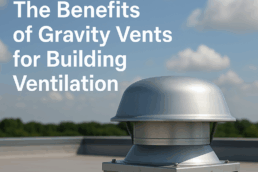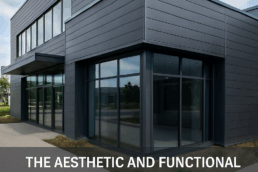Effective ventilation is essential for metal buildings to maintain air quality and prevent moisture buildup. Metal buildings are susceptible to specific challenges such as excessive heat, condensation, and poor air circulation. Without proper ventilation, these issues can lead to structural damage, corrosion, mold growth, and an uncomfortable indoor environment. This not only impacts the building’s longevity but also the health and comfort of its occupants.
Inadequate ventilation can cause significant temperature fluctuations that may to increased energy costs as heating and cooling systems work harder to compensate. Additionally, trapped moisture can deteriorate insulation, weaken structural components, and create a breeding ground for mold and mildew. Therefore, implementing an effective ventilation system is essential to ensure that your metal building remains functional, efficient, and safe.
This blog discusses various strategies for ventilation for metal buildings to make sure they remain functional and comfortable. By exploring options like ridge vents, louvers, exhaust fans, and natural ventilation, we will help you identify the best methods to maintain optimal airflow and air quality in your metal building.
Steel Building Ventilation Systems
1. Ridge Vents
- Continuous Airflow: Ridge vents are one of the most effective ventilation solutions for metal buildings. Installed along the peak of the roof, these vents allow hot air to escape and promote continuous airflow throughout the structure.
As hot air rises, it exits through the ridge vents, drawing in cooler air from lower vents or openings. This natural convection process helps maintain a consistent temperature and prevents heat buildup, which is particularly important in warmer climates.
- Energy Efficiency: In addition to promoting continuous airflow, ridge vents contribute to energy efficiency. By allowing hot air to escape, they reduce the need for air conditioning which may lead to lower cooling costs. Properly ventilated buildings are easier to cool, as the HVAC systems do not have to work as hard to maintain a comfortable temperature. This results in significant energy savings over time.
2. Louvers
- Air Intake: Louvers are an excellent solution for facilitating air intake while keeping out rain and debris. Typically installed on the sides of the building, louvers allow fresh air to enter the structure while preventing water and other elements from getting inside. This is especially important for maintaining indoor air quality and preventing moisture-related issues such as mold and mildew.
- Aesthetic Appeal: Beyond their functional benefits, louvers can also enhance the aesthetic appeal of a metal building. They are available in various designs and finishes which enables them to be integrated easily into the building’s architecture. Whether aiming for a modern look or a more traditional appearance, louvers can be customized to match the building’s design while providing essential ventilation.
3. Exhaust Fans
- Forced Ventilation: Exhaust fans provide a forced ventilation solution, actively removing hot air and moisture from inside the building. Unlike passive ventilation systems that rely on natural airflow, exhaust fans can be controlled to operate as needed.
They are ideal for areas requiring a more controlled environment. For example, in industrial settings or workshops where heat and humidity levels can fluctuate, exhaust fans ensure consistent air quality and comfort.
- Controlled Environment: Exhaust fans are particularly useful in spaces where specific environmental conditions must be maintained. By removing stale air and introducing fresh air, these fans help regulate temperature and humidity levels for a more stable and comfortable environment. This is vital for preserving equipment, materials, and the well-being of occupants.
4. Natural Ventilation
- Openings and Windows: Natural ventilation is a cost-effective solution that utilizes openings and windows to facilitate airflow. By strategically placing windows and vents, you can create a natural path for air to flow through the building. This method utilizes the wind and temperature differences between the interior and exterior to drive air circulation. It effectively reduces heat and improves air quality.
- Cost-Effective: One of the primary advantages of natural ventilation is its low cost. Unlike mechanical systems that require electricity and maintenance, natural ventilation relies on simple openings and the natural movement of air. This makes it an economical choice for improving ventilation in metal buildings. It’s particularly valued in regions with moderate climates where extreme temperatures are not a major concern.
Implementing effective ventilation strategies in metal buildings is essential for maintaining a healthy and comfortable environment. Whether through ridge vents, louvers, exhaust fans, or natural ventilation, each method offers benefits that contribute to optimal airflow and air quality. Choosing the right combination of these strategies will depend on the specific needs and design of your building.
Proper ventilation not only improves comfort but also protects the structural integrity of the building by preventing moisture buildup and heat-related damage. By investing in effective ventilation solutions, you can ensure that your metal building remains functional, energy-efficient, and comfortable for years to come.
Looking to enhance the ventilation in your metal building? Contact C&J Metal Products for high-quality, custom sheet metal fabrication solutions that can personalized to your needs. Our expert team is ready to help you design and implement the perfect ventilation system for your building.



